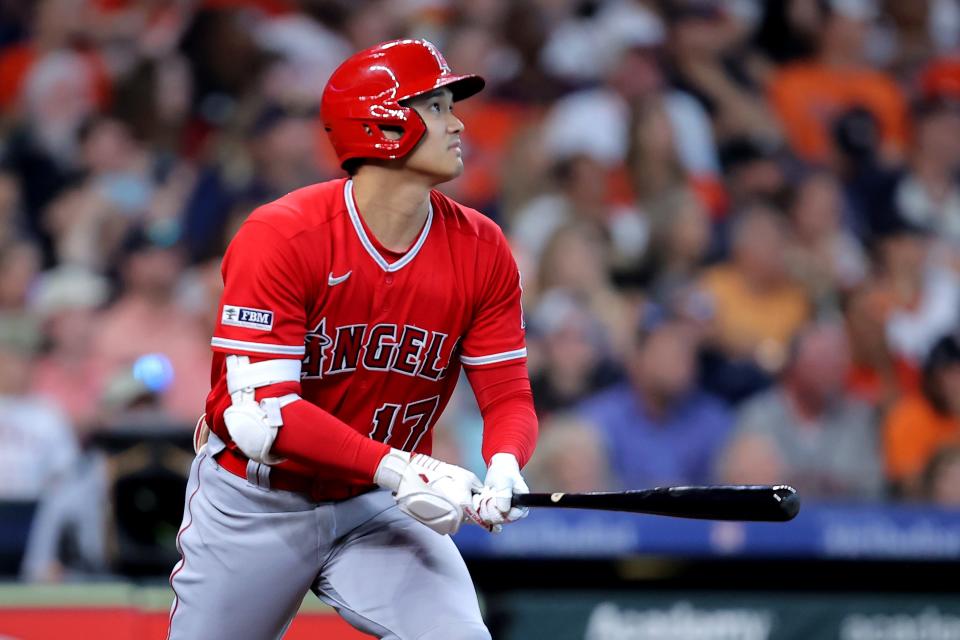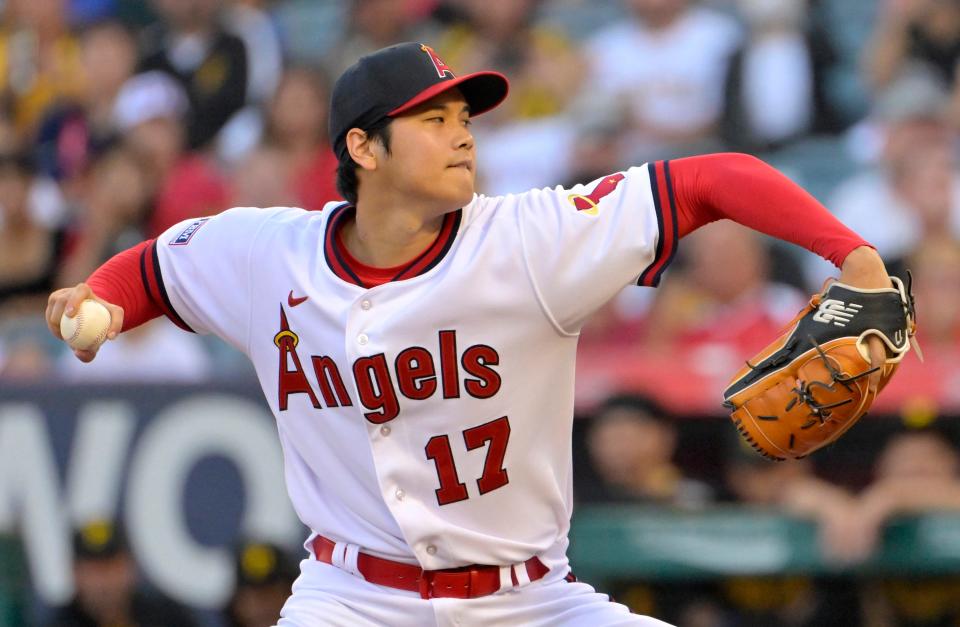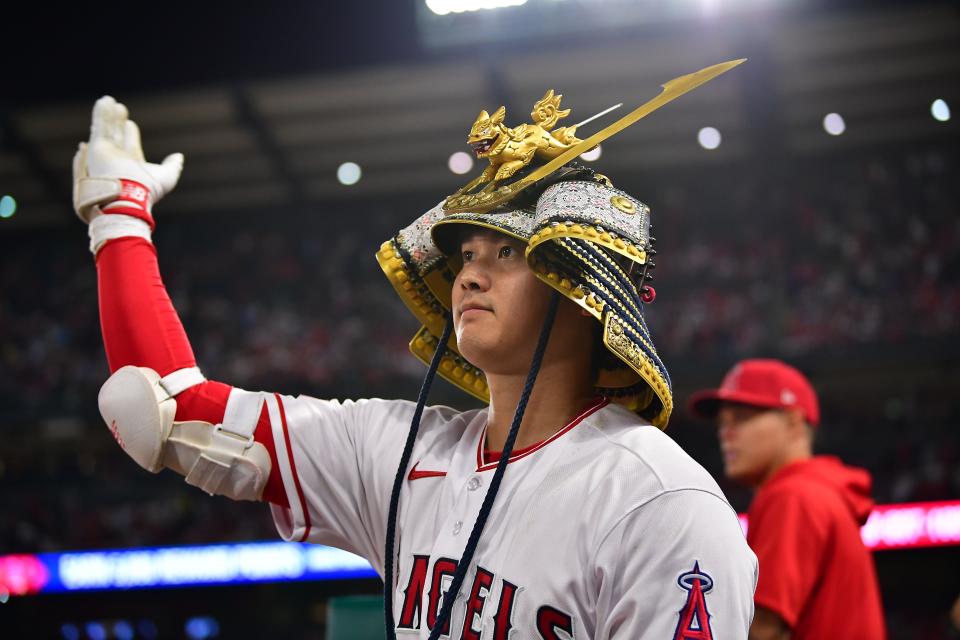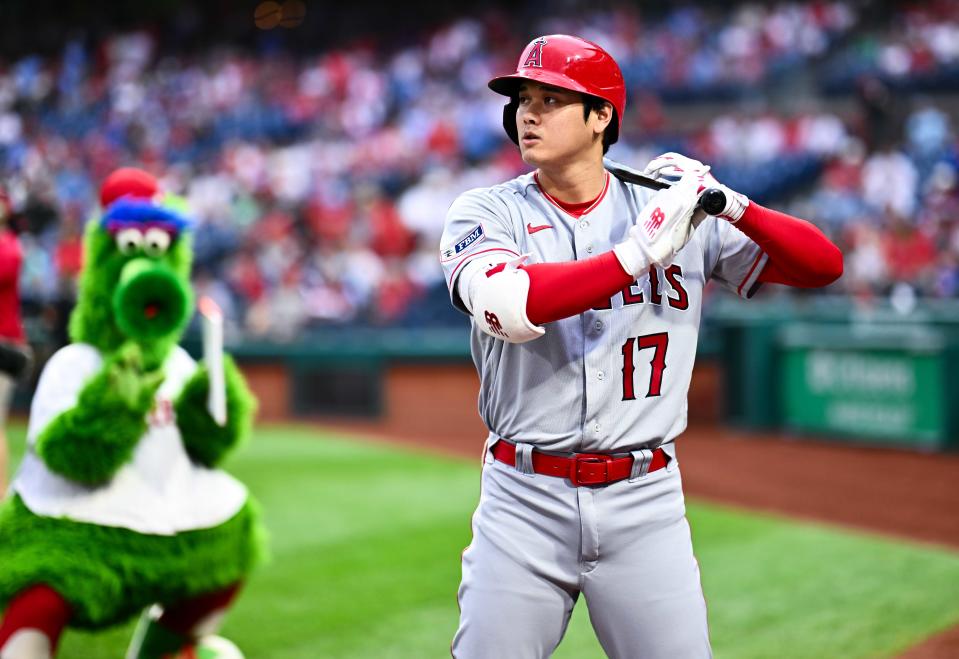Shohei Ohtani is MLB's best free agent ever. Will MVP get $500 million even with injury?
Shohei Ohtani’s unprecedented feats should endure for at least a decade. Yet one of his greatest gifts to baseball fans is a parlor game that will soon expire.
Just how much is the greatest two-way player in history worth on the open market?
For the better part of two years, it’s been pure conjecture mixed with a little math and a lot more vibes. Now, Ohtani is actually a free agent, and both well-informed projections and pie-in-the-sky dreams will give way to reality, perhaps in the next month or so.
And with all the data points in – his pitching dominance, his hitting exploits, his significant health concerns, and a grim free agent market coupled with dozens of thirsty teams aiming to compete in an expanded-playoff reality – it’s time for one more meditation on value.
So let’s start from the top and work backward: 10 years, $684 million.
Nuts, right?
No, we don’t actually think Ohtani will command that much once his recruitment hits high gear. Simply, $684 million is the combined value of the biggest free agent contracts in history for a position player (Aaron Judge, nine years, $360 million) and pitcher (Gerrit Cole, nine years, $324 million).
And it’s a little uncanny how often both men come up in recent statistical comparisons to Ohtani.
Those contracts were both doled out by the New York Yankees in the past four offseasons, and inflation has only been good for free agents since Cole signed in December 2019. Yet even in the healthiest times, the functionality of Ohtani’s two-way brilliance doesn’t allow him to average 33 starts per year, as Cole has since 2021.
Nor has it enabled him to play more than 135 games in three of his five full major league seasons, bookended by a pair of elbow reconstruction surgeries.
Yet at 29, Ohtani is the same age as Cole when the right-hander signed his deal, and a year younger when Judge set the position-player standard.
Tough equation, eh?
Well, we’ll try once more to solve it before this thing gets settled for reals, and a lucky – and well-heeled – suitor reels in arguably the most remarkable player in baseball history:

Ohtani: The hitter
It’s easy for the mind’s eye to recall Ohtani as a dominant two-way force since he transitioned from Japan to Major League Baseball. Yet a blown ulnar collateral ligament suffered as a pitcher just two months into his big league career initially curtailed his production on both sides of the ball.
Since his 2018 debut, Ohtani ranks 10th among major leaguers with 171 home runs (Atlanta’s Matt Olson leads with 206) and seventh with a .922 OPS (teammate Mike Trout is tops at 1.024).
Yet the 60-game COVID-19 season serves as a key line of demarcation for Ohtani. He appeared in two games as a pitcher at the tail end of that truncated season, his progression from Tommy John surgery complete.
And when baseball returned at full capacity, Ohtani truly took off.
Since 2021, Ohtani ranks second in the majors in OPS, his .964 mark trailing only Judge’s 1.017. His 124 homers rank fourth behind Judge (138), Olson (127) and Kyle Schwarber (125).
And he’s fourth in adjusted OPS, a key metric since he gets dinged for having the vast majority of his plate appearances at designated hitter. Ohtani’s 161 mark trails only Judge (178), Houston’s Yordan Alvarez (163) and Trout (162).
At this point, it’s key to note that among those four in that stretch, Ohtani has the most plate appearances – 1,904, compared to Judge’s 1,787, Alvarez’s 1,655 and Trout’s 1,007.
Yep, despite requiring another UCL repair and throwing 100-ish pitches once a week, Ohtani is more durable than his superstar hitting peers.
Sure, those big power numbers come at some cost – Ohtani ranks 10th with 493 strikeouts since 2021. But again, Judge’s 6-7 shadow only illuminates Ohtani: They have an identical strikeout rate – 25.9% - in that span.
While it’s uncertain how Ohtani’s athleticism changes with age, we’d be remiss not to mention that he led the majors with eight triples in 2021, the same year he stole 26 bases under the old, less liberal rules. Ohtani snagged 20 more bags this year.
We’re not here to start another Judge-Ohtani fan skirmish; it’s actually kind of cool that the two bicoastal stars will alternate MVP awards over this three-year stretch.
But it’s not a stretch to suggest Judge’s contract serves as at least a baseline for Ohtani’s value with a bat in his hands.

Ohtani: The pitcher
If it seems like Ohtani is equally dominant in both his vocations, well, you’re not imagining it.
According to Baseball-Reference’s version of Wins Above Replacement, Ohtani ranks 18th among position players since 2021 with 14.3 WAR.
In that same stretch, he’s produced 14.2 WAR as a pitcher.
Yet while Ohtani trails more than a dozen players in position-player WAR (Judge is first at 21.2), he’s tied for fifth among pitchers – likely an indication that even the greatest teams can’t scrounge up enough competent starting pitchers.
The top five in pitching WAR since 2021 are somewhat instructive to Ohtani’s value there.
No. 1 is Zack Wheeler (16.8 WAR), who signed a five-year, $118 million deal with Philadelphia before the 2020 season, a mild leap by the Phillies since Wheeler had never reached 200 innings and only twice made at least 30 starts in his six seasons prior.
No. 3 is Sandy Alcantara (15.5), who opted for early financial security in signing a five-year, $56 million deal after his third full season.
No. 4 is Max Scherzer (14.5), who commanded a $43.3 million annual salary even as that contract takes him to his 40th birthday.
And No. 2, at 15.6, is Cole.
The likely 2023 AL Cy Young winner probably hasn’t received enough love for more than living up to the first four years of his landmark contract – he’s led the majors with 722 strikeouts and 44 wins in our 2021-23 sample, and his 1.02 WHIP ranks fourth among the top 20 WAR crowd.
Ohtani can’t quite reach that rent district.
He ranks 14th in that span with 542 strikeouts in 74 starts; since Ohtani typically pitches just once a week while most starters go every fifth day, everyone else in the top 15 started between 80 and 97 games the past three years.
Ohtani fares better in strikeouts per nine innings, ranking 10th with 11.4 among starters. Drill down further, and he ranks third, behind Blake Snell and Dylan Cease, among pitchers who have started at least 15 games all three years.
As for earned-run average? Ohtani’s 2.84 mark ranks sixth among starters who have thrown at least 300 innings over the past three years; Cole’s 3.11 ranks 15th.
Still, the ability to post reigns supreme among the game’s horses. Cole has pitched 591 very quality innings since 2021, compared to Ohtani’s 428 ⅓.
That’s 72% of Cole’s innings total. For those of you applying the simplest of math at home, 72% of $324 million over nine years is $233.3 million, or $26 million as a pitcher per year.
Gulp.

Ohtani’s kryptonite
Alas, Ohtani’s new team (or old, if he re-signs with the Los Angeles Angels) won’t enjoy that portion of Sho-Time until at least 2025. Ohtani’s second reconstruction of the ulnar collateral ligament in his right elbow will keep him from the pitching mound all of next season, and probably a portion of the following one.
Agent Nez Balelo and the Angels were careful not to reveal whether this procedure, performed in September by orthopedist Neal ElAttrache, was Tommy John surgery. Two-time Cy Young Award winner Jacob deGrom took a similar informational path when he underwent a second surgery for a torn UCL.
Regardless of what ElAttrache found and repaired in the elbow, the second procedure is far from a death knell for Ohtani the pitcher, but certainly raises concerns for an acquiring team.
You need look no further than the final game of 2023 to find a two-time Tommy John success story: Nathan Eovaldi had the procedure twice and has gone on to pitch for two World Series winners, getting the win for the Rangers in Game 5 to finish off the Diamondbacks. With the recent rash of hard-throwing two-time UCL victims, Ohtani will have plenty of company: Walker Buehler, Shane McClanahan and deGrom are among the former All-Stars also returning from a second surgery.
The procedure has improved its success rate significantly, and clubs can be relatively confident that by 2026, Ohtani will resemble the dominant ace he was the past three seasons. Yet the greatest fear, particularly in a contract the length Ohtani will command, is another UCL tear.
How might a club build in protections for a scenario that may confine Ohtani merely to hitting? Will the orthopedic world continue innovating elbow repairs – such as the internal brace option - that can ensure better success for three-time victims ?
They are all significant uncertainties surrounding a player who inspires only awe and confidence beyond a tiny ligament in his right elbow.

Another path forward?
Ohtani was, essentially, a one-person lab experiment the past six years. He and the Angels developed a plan for him as a two-way player that worked to phenomenal success. (Save for the UCL tears, which might have been unavoidable regardless of usage).
The question going forward is whether his routine – pitching roughly once a week, serving as DH the rest of the time and steadfastly avoiding playing the field – might ever be subject to change.
Ohtani loved his comfort level in Anaheim, and industry speculation suggests that may prod him toward a return there despite the Angels’ well-documented on-field futility. But unlike Ohtani’s first informational tour of the majors that preceded his signing with the Angels, there’s a six-year sample to chew on.
And beyond tourist videos and teammate testimonials, teams courting Ohtani may also present alternate modes of usage.
Maybe Ohtani 2021-23 is the maximum version of himself. But serving strictly as DH is confining for potential suitors; aesthetically, it’s a bit of a shame that one of the world’s greatest athletes is confined to a position better fit for aging, slow-footed sluggers.
Logistically, it takes teams like the Phillies, barring a trade or two, almost out of the Ohtani running due to the presence of players like Schwarber who need a DH landing spot.
And that’s going to be the case for many of the favorites to sign him.
Take the Dodgers. First baseman Freddie Freeman is signed through 2027, by which time he’ll be 38. Mookie Betts is signed through 2033, taking him right up through his 40th birthday.
Those fellows might need a few DH days going forward; at the least, having three aging former MVPs on the roster begs for flexibility.
Perhaps the path is pitching a bit less – say, every 10 days? – and playing the field a bit more. (We’re not physiologists, simply spitballing).
Either way, a willingness for flexibility will only help Ohtani’s market now – and aid his future team’s roster in the future.
Consensus
Oh, you want an actual number?
Can’t blame you for asking, even if the aforementioned factors are so volatile, as is the manner in which the dozen-plus teams kicking Ohtani’s tires might quantify “value.”
Yet since it’s not our money, let’s give him the moon, and start with Judge’s nine years and $360 million. Add another year, because people love round numbers, it gives Ohtani’s club a smidge of luxury tax relief and still sends him on his way before his 40th birthday.
The pitching piece? The elbow surgery penalty? The marketing upside? The ticket sales and TV ratings bumps?
Hoo, now we’re sailing into the unknowable. But bidders don’t have the luxury of certainty. The winner does buy years and years of credibility with their fan base; ask the Phillies and Padres how much that can matter.
And they also enjoy the services of an all-time great, still in his prime.
Let’s keep it neat: Ten years, $510 million, making Ohtani baseball’s first $50 million man and blowing away the standard for total value in a North American sports contract.
Kind of a bargain for two MVP-caliber players, don’t you think?
This article originally appeared on USA TODAY: Shohei Ohtani is MLB's best free agent ever: $500M contract rumors

